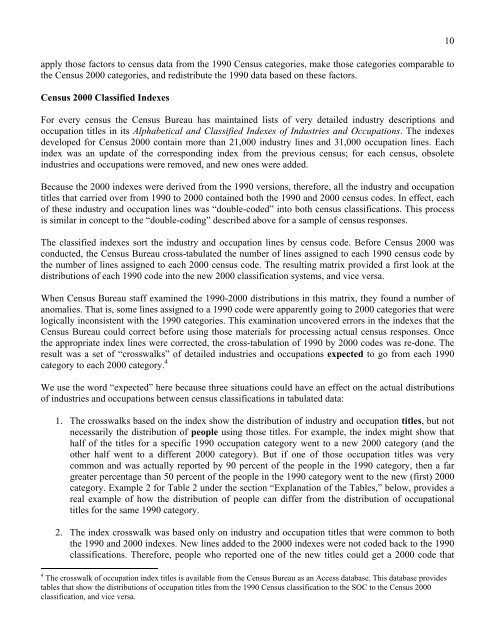The Relationship Between The 1990 Census and ... - Census Bureau
The Relationship Between The 1990 Census and ... - Census Bureau
The Relationship Between The 1990 Census and ... - Census Bureau
Create successful ePaper yourself
Turn your PDF publications into a flip-book with our unique Google optimized e-Paper software.
apply those factors to census data from the <strong>1990</strong> <strong>Census</strong> categories, make those categories comparable to<br />
the <strong>Census</strong> 2000 categories, <strong>and</strong> redistribute the <strong>1990</strong> data based on these factors.<br />
<strong>Census</strong> 2000 Classified Indexes<br />
For every census the <strong>Census</strong> <strong>Bureau</strong> has maintained lists of very detailed industry descriptions <strong>and</strong><br />
occupation titles in its Alphabetical <strong>and</strong> Classified Indexes of Industries <strong>and</strong> Occupations. <strong>The</strong> indexes<br />
developed for <strong>Census</strong> 2000 contain more than 21,000 industry lines <strong>and</strong> 31,000 occupation lines. Each<br />
index was an update of the corresponding index from the previous census; for each census, obsolete<br />
industries <strong>and</strong> occupations were removed, <strong>and</strong> new ones were added.<br />
Because the 2000 indexes were derived from the <strong>1990</strong> versions, therefore, all the industry <strong>and</strong> occupation<br />
titles that carried over from <strong>1990</strong> to 2000 contained both the <strong>1990</strong> <strong>and</strong> 2000 census codes. In effect, each<br />
of these industry <strong>and</strong> occupation lines was “double-coded” into both census classifications. This process<br />
is similar in concept to the “double-coding” described above for a sample of census responses.<br />
<strong>The</strong> classified indexes sort the industry <strong>and</strong> occupation lines by census code. Before <strong>Census</strong> 2000 was<br />
conducted, the <strong>Census</strong> <strong>Bureau</strong> cross-tabulated the number of lines assigned to each <strong>1990</strong> census code by<br />
the number of lines assigned to each 2000 census code. <strong>The</strong> resulting matrix provided a first look at the<br />
distributions of each <strong>1990</strong> code into the new 2000 classification systems, <strong>and</strong> vice versa.<br />
When <strong>Census</strong> <strong>Bureau</strong> staff examined the <strong>1990</strong>-2000 distributions in this matrix, they found a number of<br />
anomalies. That is, some lines assigned to a <strong>1990</strong> code were apparently going to 2000 categories that were<br />
logically inconsistent with the <strong>1990</strong> categories. This examination uncovered errors in the indexes that the<br />
<strong>Census</strong> <strong>Bureau</strong> could correct before using those materials for processing actual census responses. Once<br />
the appropriate index lines were corrected, the cross-tabulation of <strong>1990</strong> by 2000 codes was re-done. <strong>The</strong><br />
result was a set of “crosswalks” of detailed industries <strong>and</strong> occupations expected to go from each <strong>1990</strong><br />
category to each 2000 category. 4<br />
We use the word “expected” here because three situations could have an effect on the actual distributions<br />
of industries <strong>and</strong> occupations between census classifications in tabulated data:<br />
1. <strong>The</strong> crosswalks based on the index show the distribution of industry <strong>and</strong> occupation titles, but not<br />
necessarily the distribution of people using those titles. For example, the index might show that<br />
half of the titles for a specific <strong>1990</strong> occupation category went to a new 2000 category (<strong>and</strong> the<br />
other half went to a different 2000 category). But if one of those occupation titles was very<br />
common <strong>and</strong> was actually reported by 90 percent of the people in the <strong>1990</strong> category, then a far<br />
greater percentage than 50 percent of the people in the <strong>1990</strong> category went to the new (first) 2000<br />
category. Example 2 for Table 2 under the section “Explanation of the Tables,” below, provides a<br />
real example of how the distribution of people can differ from the distribution of occupational<br />
titles for the same <strong>1990</strong> category.<br />
2. <strong>The</strong> index crosswalk was based only on industry <strong>and</strong> occupation titles that were common to both<br />
the <strong>1990</strong> <strong>and</strong> 2000 indexes. New lines added to the 2000 indexes were not coded back to the <strong>1990</strong><br />
classifications. <strong>The</strong>refore, people who reported one of the new titles could get a 2000 code that<br />
4 <strong>The</strong> crosswalk of occupation index titles is available from the <strong>Census</strong> <strong>Bureau</strong> as an Access database. This database provides<br />
tables that show the distributions of occupation titles from the <strong>1990</strong> <strong>Census</strong> classification to the SOC to the <strong>Census</strong> 2000<br />
classification, <strong>and</strong> vice versa.<br />
10
















